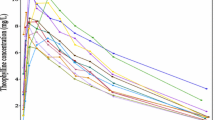Abstract
In pharmacokinetic data analysis, it is frequently necessary to select the number of exponential terms in a polyexponential expression used to describe the concentration-time relationship. The performance characteristics of several selection criteria, the Akaike Information Criterion (AIC), and the Schwarz Criterion (SC), and theF test (α=0.05), were examined using Monte Carlo simulations. In particular, the ability of these criteria to select the correct model, to select a model allowing estimation of pharmacokinetic parameters with small bias and good precision, and to select a model allowing precise predictions of concentration was evaluated. To some extent interrelationships among these procedures is explainable. Results indicate that theF test tends to choose the simpler model more often than does either the AIC or SC, even when the more complex model is correct. Also, theF test is more sensitive to deficient sampling designs. Clearance estimates are generally very robust to the choice of the wrong model. Other pharmacokinetic parameters are more sensitive to model choice, particularly the apparent elimination rate constant. Prediction of concentrations is generally more precise when the correct model is chosen. The tendency for theF test (α=0.05) to choose the simpler model must be considered relative to the objectives of the study.
Similar content being viewed by others
References
J. G. Wagner. Linear compartment models. In Fundamentals of Clinical Pharmacokinetics, Drug Intelligence Publications Inc., Hamilton, Ill., 1975, pp. 57–128.
J. G. Wagner. Do you need a pharmacokinetic model, and, if so, which one?J. Pharmacokin. Biopharm. 3:457–478 (1975).
D. J. Cutler. Numerical deconvolution by least squares. Use of prescribed input functions.J. Pharmacokin. Biopharm. 6:227–241 (1978).
H. G. Boxenbaum, S. Riegelman, and R. M. Elashoff. Statistical estimation in pharmacokinetics.J. Pharmacokin. Biopharm. 2:123–148 (1972).
K. Yamaoka, T. Nakagawa, and T. Uno. Application of Akaike's Information Criterion (AIC) in the evaluation of linear pharmacokinetic equations.J. Pharmacokin. Biopharm. 6:165–175 (1978).
H. Akaike. Information theory and an extension of the maximum likelihood principle, In B. N. Petrov and F. Csaki (eds.), 2nd International Symposium on Information Theory, Akademai Kiado, Budapest, 1973, pp. 267–281.
H. Akaike. A new look at the statistical model identification.IEEE Trans. Automat. Contr. 19:716–723 (1974).
G. Schwarz. Estimating the dimension of a model.Ann. Statist. 6:461–468 (1978).
A. C. Atkinson. Posterior probabilities for choosing a regression model.Biometrika 65:39–48 (1978).
B. P. Imbimbo, E. Imbimbo, S. Daniotti, D. Verotta, and G. Bassotti. A new criterion for selection of pharmacokinetic multiexponential equation.J. Pharm. Sci. 77:784–798 (1988).
B. P. Imbimbo, P. Martinelli, M. Rocchetti, G. Ferrari, G. Bassotti, and E. Imbimbo. Efficiency of different criteria for selecting pharmacokinetic multiexponential equations.Biopharm. Drug Dispos. 12:139–147 (1991).
S. L. Beal. Some clarification regarding moments of residence times with pharmacokinetic models.J. Pharmacokin. Biopharm. 15:75–92 (1987).
G. E. P. Box and M. Muller. A note on the generation of random normal deviates.Ann. Math. Statist. 29:610–611 (1958).
D. W. Marquardt. An algorithm for least squares estimation of nonlinear parameters.SIAM J. 11:431–441 (1963).
F. J. Burguillo, A. J. Wright, and W. G. Bardsley. Use of the F-test for determining the degree of enzyme-kinetic and ligand-binding data. A Monte Carlo simulation study.Biochem. J. 211:23–34 (1983).
W. G. Bardsley, P. B. McGinlay, and A. J. Wright. The F-test for model discrimination with exponential functions.Biometrika 73:501–508 (1986).
Author information
Authors and Affiliations
Additional information
This work was supported in part by Grant No. 26676 from the National Institutes of General Medical Sciences, National Institutes of Health.
Rights and permissions
About this article
Cite this article
Ludden, T.M., Beal, S.L. & Sheiner, L.B. Comparison of the Akaike Information Criterion, the Schwarz criterion and the F test as guides to model selection. Journal of Pharmacokinetics and Biopharmaceutics 22, 431–445 (1994). https://doi.org/10.1007/BF02353864
Received:
Accepted:
Published:
Issue Date:
DOI: https://doi.org/10.1007/BF02353864




